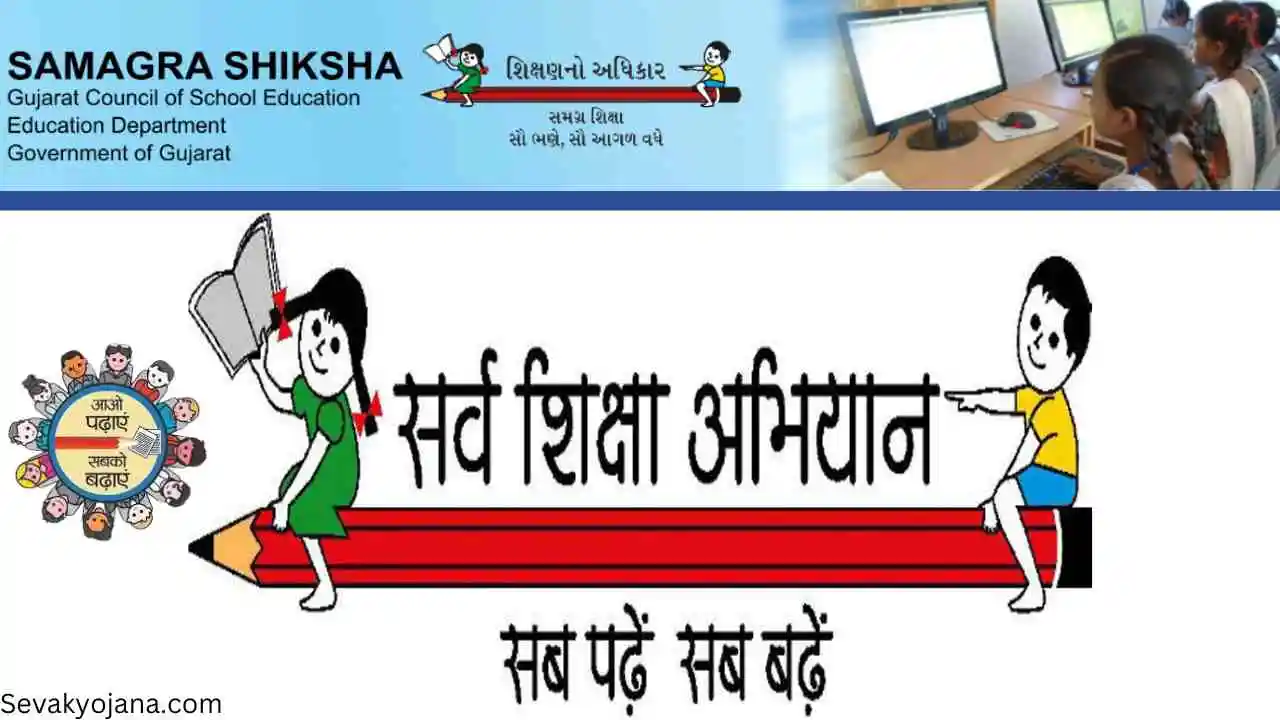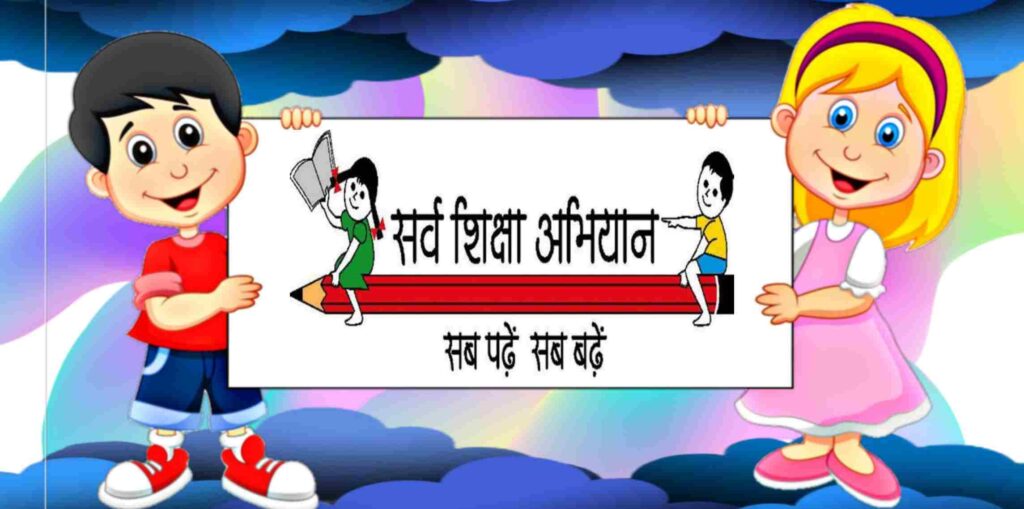Sarva Shiksha Abhiyan: Sarva Shiksha Abhiyan (SSA) is a significant government program in India. It aims to achieve Universalization of Elementary Education (UEE) as mandated by the 86th Amendment to the Constitution. This amendment makes education free and compulsory for children between the ages of 6 and 14.
The SSA program is a collaborative effort between the central and state governments. Its objective is to reach 1.92 lakh children across 1 lakh habitations. The primary mission of SSA is to provide quality education to all children in this age group, ensuring they have access to education, regardless of their background or location.
The program aims to improve the current school infrastructure by providing funding for extra classrooms, restrooms, drinking water, maintenance grants, and school improvement grants. It also aims to establish new schools in communities without existing school facilities.
Additional teachers have been sent to areas where there are currently insufficient teachers, and the number of teachers that are currently there has been strengthened through extensive training, increased funding for the creation of teaching-learning materials, and strengthened academic support systems at the cluster, block, and district levels.
The Sarva Shiksha Abhiyan (SSA) is a comprehensive educational program with a special focus on the education of girl children and children with special needs. It recognizes the importance of ensuring that every child, regardless of their gender or abilities, has access to quality education.
Furthermore, SSA aims to bridge the digital divide by providing computer education. This initiative is vital in a rapidly advancing world, as it equips students with essential digital skills, ensuring they are not left behind in the age of technology. By incorporating computer education into the curriculum, SSA is actively preparing students for the digital challenges and opportunities of the future.
Sarva Shiksha Abhiyan
Everyone, no matter where they’re from, deserves a shot at a better life. Sadly, many kids worldwide are missing out on even the basics, like primary education. This keeps them stuck in a cycle of poverty and holds them back from a brighter future. It’s on all of us to ensure that every child gets the chance for primary education, giving them a path to a brighter and more promising life.
Thanks to literacy programs in India, by the year 2000, 94% of rural children had access to primary schools just 1 km away from their homes and upper primary schools within 3 km. Special efforts were made to ensure that more children, especially girls, from Scheduled Castes (SC) and Scheduled Tribes (ST) backgrounds were enrolled in schools.
Since the First Five Year Plan, there has been a steady rise in the number of children attending primary and upper primary schools, as well as in the number of schools. In 1950–51, only 3.1 million children were enrolled in primary education, but by 1997–98, this number had soared to 39.5 million. Similarly, the number of primary and upper primary schools increased from 0.223 million in 1950–51 to 0.775 million in 1996–97.
According to estimates, in 2002-03, about 82% of children between the ages of 6 and 14 were attending various schools. The Government of India has a clear goal to raise this figure to 100% by the end of the current decade. The commitment to education is making a positive impact on India’s future.
We all know that in order to completely eradicate poverty from the world and open the door to peace and security, it is essential to give all people the freedom to live the life they desire for themselves and their families. Only when children around the world have access to top-notch educational facilities, at least through primary school, is this goal achievable.
Sarva Shiksha Abhiyan Goal
The Sarva Shiksha Abhiyan (SSA) is a crucial initiative of the Government of India aimed at achieving universal elementary education within a specified timeframe. Thanks to the 86th Constitutional Amendment, primary education for children aged 6-14 is now a fundamental right, ensuring it’s both free and compulsory.
SSA operates in collaboration with state governments and addresses the educational needs of 19.2 lakh children in 11 lakh villages across India.
This comprehensive program encompasses several key components. Firstly, it focuses on establishing new schools in villages where educational facilities are lacking.
Additionally, it empowers existing schools by providing essential resources such as additional classrooms, toilets, access to clean drinking water, funds for repairs, and school improvement initiatives.
The ultimate goal of SSA is to ensure that every child has the opportunity to receive a quality education, regardless of their location. It’s a critical step toward fulfilling India’s commitment to providing accessible and compulsory primary education for all children.
In schools that are running but short on teachers, additional teachers will be appointed, and the existing ones will receive comprehensive training. There will also be funding allocated for the development of teaching materials, along with strengthening academic support systems at the local, district, and block levels.
Sarva Shiksha Abhiyan (SSA) is committed to providing high-quality education that equips students with essential life skills. It places particular emphasis on educating girls and underprivileged youth. Additionally, SSA aims to bridge the digital divide in the country by introducing computer education. This holistic approach ensures that every child, regardless of their background, receives a well-rounded and empowering education.
What is Sarva Shiksha Abhiyan?
- program for universal elementary education with a defined time frame.
- In response to the national call for high-quality basic education.
- A chance to advance social justice via fundamental education.
- In an effort to manage elementary education more efficiently, efforts have been made to include Tribal Autonomous Councils, School Management Committees, Rural and Urban Slum Level Education Committees, Parent-Teacher Organizations, and other land-related institutions.
- A demonstration of the political will for all citizens to receive a primary education.
- cooperation between the federal government, state governments, and local.
- A fantastic chance for states to refine their ideas about elementary education.
Sarva Shiksha Abhiyan Objectives
Here are the Objectives of the Sarva Shiksha Abhiyan (SSA) in a simplified format:
- By 2005, ensure all children have access to elementary schools, education guarantee centers, alternative education, and “back to school” camps.
- By 2007, aim for every child to complete five years of primary school.
- By 2010, strive for every child to finish eight years of education.
- Prioritize high-quality elementary education with a focus on practical life skills.
- By 2007 and 2010, respectively, eliminate discrimination based on social class and gender in primary education.
- Keep all children enrolled in school by 2010, ensuring access to education for all.
Sarva Shiksha Abhiyan Focus Area
Here are some key aspects of Sarva Shiksha Abhiyan (SSA) in simpler terms:
- Alternative Education: SSA offers different educational options to cater to various needs.
- Children with Special Needs: SSA provides support and resources for kids who require special assistance.
- Community Involvement: Communities come together to support and promote education.
- Girls’ Education: SSA focuses on ensuring that girls receive equal educational opportunities.
- Quality Primary Education: SSA strives to improve the standard of primary education.
Sarva Shiksha Abhiyan Institutional reforms
Sarva Shiksha Abhiyan (SSA) includes important changes in the education system. This involves reviewing the State Education Act, improving teacher appointments, and evaluating various aspects. It also focuses on girls’ education, underprivileged sections, private schools, early
Childhood care and education (ECCE), financial matters, school performance, community involvement, and monitoring. These changes are intended to enhance elementary education in different states.
Sarva Shiksha Abhiyan Sustainable funding
The foundation of SSA is the idea that programs for elementary education should continue to be funded. It is necessary to have a long-term view of the financial cooperation between the federal and state governments.
Sarva Shiksha Abhiyan Community ownership
To make sure the community is involved, we need to decentralize school programs effectively. This means women’s groups, village education committee members, and local government representatives will be part of expanding the program.
Their participation will help customize the program to fit each community’s needs better.
Sarva Shiksha Abhiyan Institutional Capacity Building
Sarva Shiksha Abhiyan (SSA) relies on institutions like the National Institute of Educational Planning and Administration, along with state and local bodies such as the State Council of Educational Research and Training (SIEMAT) and the National Council of Teacher Education for capacity building.
Establishing a system with continuous expert support is crucial for improving and maintaining educational standards. This ongoing support helps ensure the success of the program.
Sarva Shiksha Abhiyan Reform of the main stream of educational administration

Through institutional growth, the adoption of fresh initiatives, and the use of efficient and cost-effective procedures, it is anticipated to enhance the general practice of educational administration.
Sarva Shiksha Abhiyan Community inspection with full transparency
This program will take a community-based approach. Micro Planning, Surveys, and Educational Management Information Systems will connect community-based data with school-level data.
Every school must also keep an announcement board that lists all of the grants and other information the institution has been awarded.
Sarva Shiksha Abhiyan Township as planning unit
SSA uses a community-based planning methodology, using Basti as the planning unit. District plans will be created using township plans as a foundation.
Sarva Shiksha Abhiyan The role of teachers
The Sarva Shiksha Abhiyan encourages addressing teachers’ developmental needs and acknowledges the critical role they play in society. The goal of developing human resources among teachers is achieved through the establishment of Block Resource Centers and Community Resource Centers.
the hiring of qualified teachers, chances for teacher development through collaboration in the creation of curriculum, emphasis on educational processes, and teacher exposure visits.
Sarva Shiksha Abhiyan Financial Norms
- Financial partnership between Central and State Governments for Sarva Shiksha Abhiyan 85:15 during the Ninth Plan period; In the Tenth Plan, it will be 75:25 and thereafter it will be 50:50. The commitment to bear the cost will be taken in writing from the State Governments. The State Governments will have to maintain the investment in elementary education in 1999-2000 and the State share in SSA will be in addition to this investment.
- The Government of India will release the funds directly to the State Implementing Societies and the Central Government will release the next instalment only after transferring at least 50% of the State Government’s share to the State Implementing Societies and spending this amount.
- The share of central government and state government in the salaries of teachers appointed under SSA will be in the ratio of 85:15 during the Ninth Plan period, 75:25 during the Tenth Plan period and 50:50 thereafter.
- Until a specific amendment is agreed upon in consultation with the agency providing foreign funds, all legal agreements pertaining to projects that receive external assistance will remain in effect.
- The Department’s current plans will be combined with the National Council for Teacher Education and the Ninth Plan. The National Nutritional Support Programme Scheme for Primary Education (MDPS), a special program where the Central Government pays for food grains and transportation while the State Governments pay for cooking, will remain in place.
- The District Education Plan, among other things, makes it abundantly evident that programs such as the Assured Employment Scheme, the Jawahar Rozgar Yojana, the Pradhan Mantri Rozgar Yojana, the Regional Funds for MPs and MLAs, the State Plans, and the foreign funds and resources raised in the private sector will supply funds or funds from various components. There are resources made available.
- The equipment that local management and schools use for improvement, upkeep, repair, and instruction.
Sarva Shiksha Abhiyan How to apply
To receive the benefits of this program, enroll in any government-run or government-recognized Indian school.
For further details, please download the file.
[su_button url=”https://cdn.s3waas.gov.in/s388ae6372cfdc5df69a976e893f4d554b/uploads/2018/07/2018072639.pdf” target=”blank” style=”flat” background=”#b6190e” size=”10″ center=”yes” radius=”round”]Download[/su_button]

